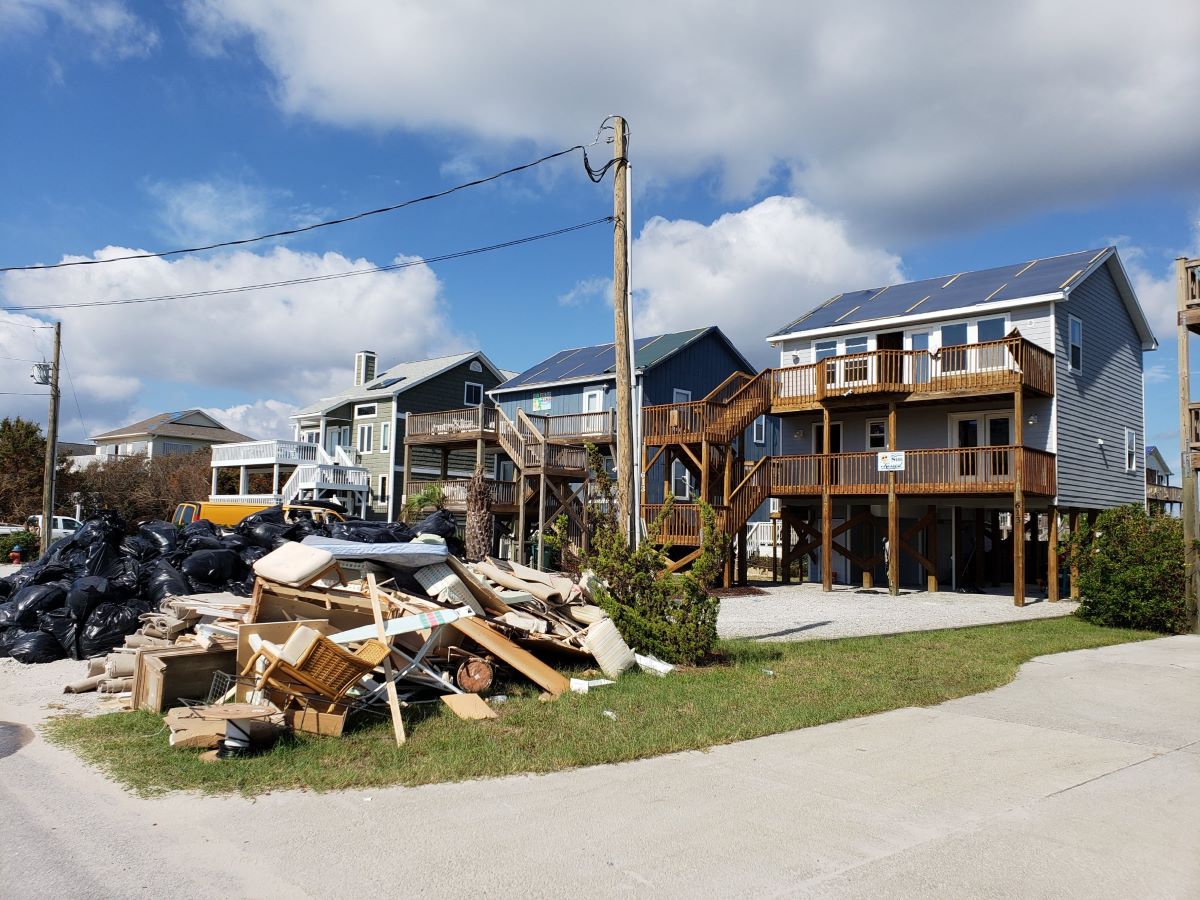
Second in a series.
Maybe one North Carolina insurance provider should join the industry trend and advertise: “Hello Beach Plan policyholders! Do you need a new roof? Want to save on your property insurance? How about we help you out with as much as $8,000 toward a much stronger roof that is fortified to withstand storms? And don’t worry — we’re not asking you to pay it back.”
Even with those selling points, the North Carolina Insurance Underwriting Association, or NCIUA, which runs the Beach Plan, has yet to reach the number of property owners who could benefit from the Strengthen Your Roof grant program it offers to its policyholders.
“The question was, how do we incentivize consumers so that they desire a new roof as much as they desire a beautiful countertop?” Gina Hardy, general manager and chief executive officer of N.C. Insurance Underwriting Association and N.C. Joint Underwriting Association, said in an interview.
“We had given credits to policyholders who installed fortified roofs, but in 2016, we started running pilot programs to motivate them to engage in mitigation,” Hardy said.
To be clear, that motivation is money in the form of a grant. To fund the grant program, Hardy said the insurance provider made a business case that the grants would help homeowners build more wind-resistant roofs, which would result in savings on future claims and reinsurance costs.
The North Carolina Joint Underwriting Association administers the Fair Access to Insurance Requirements, or FAIR, Plan is a tax-exempt organization of insurance companies that do property insurance in the state. The North Carolina Insurance Underwriting Association, or Beach Plan, is similar but is specifically for providing essential coverage in coastal and beach zones.
At a time when North Carolina’s coastal homeowners are more immediately worried about rising costs of property insurance and its availability than rising seas, insurance providers are looking askance at growing risks from climate change-related impacts and the ballooning costs of disaster claims.
Meanwhile, forecasters are predicting a very active hurricane season in 2024.
Proactive resilience measures such as N.C. Insurance Underwriting Association’s Strengthen Your Roof program, which provides the grants to install the trademarked Insurance Institute for Business and Home Safety, or IBHS, Fortified Roof are helping to decrease a significant part of that risk.
Data from IBHS, the South Carolina-based research nonprofit that developed the roof, shows that up to 90% of insured catastrophic residential property losses are related to roof failures.
As described by IBHS, Fortified is a voluntary re-roofing program, designed to be stronger in winds, hail and hurricanes based on field research of real houses after storms. Installation of a fortified roof involves removing the existing roof to the decking, sealing the deck, and using stronger nails and nail attachments, and roof mounted vents.
Recent research on the effectiveness of IBHS roofs by N.C. State University’s School of Data Analytics found a reduction of about 35% in reported claims and 23% in the amount of payment in filed claims for hurricanes Matthew in 2016, Florence in 2018, Dorian in 2019, and Isaias in 2020.
When the pilot program first launched, only four houses on the coast out of over 400,000 policyholders had participated in the program by December 2016, Hardy said. Still, it was innovative enough to inspire invitations to both the White House and the World Bank in late 2016.
But Strengthen Your Roof has grown steadily since its underwhelming start. In April 2019, 274 eligible houses had fortified roofs. As of September 2023, the grant program’s completed roofs and applications totaled 5,928.
“This is a great program!” 2023 grant participant Joseph Connolly Ely of New Bern said in feedback provided on the program’s website. “Homeowners get a cash grant, a reduction on their wind and hail insurance premium AND peace of mind from the reduced likelihood that their roof will fail in a hurricane.
“The NCIUA, in turn, has a reduced likelihood that they will have to pay a large claim due to such a roof failure,” he added, “so it really is a win-win program.”
Who is this program for?
Billed as one of the first efforts in the nation to help policyholders in hurricane zones to better protect their homes from the storms, the IBHS program is offered to its eligible policyholders on the Outer Banks and barrier islands.
The grants are available on a first-come, first-served basis until the end of this year, or when all funds are awarded. The program also expanded two years ago to the other 18 coastal counties the Insurance Underwriting Association serves.
Part of the slow response from the public to the program may be confusion about the requirements, which includes having an evaluator ensure qualification for the IBHS designation, and a contractor who is trained to build a fortified roof.
“So, it was definitely an uphill battle trying to get everyone to understand IBHS was doing fantastic science, but we were not getting that science implemented for the benefit of our coastal residents and our policyholders,” Hardy said.
Now known officially as the Coastal Property Insurance Pool, the Beach Plan, also referred to as the market of last resort, was created in 1969 by the North Carolina General Assembly to provide adequate property insurance for homeowners in the state who could not otherwise obtain coverage in the private market.
About 70% of homeowner policies in coastal North Carolina counties are insured for wind and other hazards under the Beach Plan. Separate flood insurance policies, required for mortgaged properties in flood zones, are provided by a Federal Emergency Management Agency program.
What is IBHS?
IBHS, which researches mitigation and resiliency across the country, is funded by insurers and re-insurers. First established in 1977 as the National Committee on Property Insurance, it has since changed its name and expanded its focus numerous times.
In 2010, the IBHS Research Center was created in South Carolina “to advance the scientific understanding of severe weather perils and their interaction with the homes and businesses at full scale,” according to its website, referring to wind, hail, rain and wildfire.
“We study those four primary perils as we conduct that research and we gain understanding of how buildings are interacting and how different systems like the roof, like windows and doors resist flying projectiles . . . how they interact with the wind,” said Fred Malik, managing director of Fortified. “We are charged by our member companies to reduce avoidable losses and financial hardship for their clients and our customers.”
Besides its roofs, IBHS offers Fortified construction techniques to strengthen the overall structure of a house as options for property owners.
In general, the institute claims that Fortified methods reduce emergency management and disaster recovery costs, decrease insurance losses, increase availability and affordability of insurance, and minimize disruptions and uninsured losses to homeowners.
The argument for fortified roofs
Data shows that fortified roofs work better than standard roofs, said Donald Hornstein. He is chair of the N.C. Insurance Underwriting Association board of director’s mitigation committee and a professor at the University of North Carolina School of Law who, among other subjects, specializes in insurance law, regulatory law and environmental law.
“It’s just a matter of whether or not the relatively modest additional costs of requiring fortified roofs should be adopted,” Hornstein told Coastal Review. “So that’s a straight-up political fight — it’s not an expertise fight.”
Hornstein explained that the insurance provider has spent $50 million of its own funds for the roof program “because we make money.” Estimates show that for every $50 million invested, within 10 years $65 million in avoided claims will be saved, as well as reduced reinsurance costs.

“These fortified roofs are definitely cost effective,” Hornstein said.
That’s why some states, like Alabama, require them, and others pay homeowners the additional cost, which averages about $2,300, to install a fortified roof when they’re re-roofing.
“So basically, if you don’t compel people to do it,” he said, “you bribe them to do it.”
Other states offer grants, and although the North Carolina legislature has provided funds, much of Strengthen Your Roof grant program has been paid for out of the N.C. Insurance Underwriting Association surplus fund.
With the average cost of roof replacement at least $12,000 or more, depending on factors such as location and home size, people often put it off until the last minute. But the hope is that by offering policyholders the $8,000 grant, Hornstein said, they will see the advantage of applying for the stronger roof.
Using the fortified program, for instance, could make homeowners property insurance eligible for mitigation credits, according to the state Department of Insurance.
How is it funded?
The General Assembly allocated $7 million to match the N.C. Insurance Underwriting Association’s allocation for grants for the expanded program. The 2023 Strengthen Your Roof Program was launched with a $20 million allocation from the insurance provider, which then increased the grant amount from $6,000 to $8,000 for the Outer Banks and Barrier Islands.
Legislators provided only $2 million of the $20 million requested last year for matching funds, but the spell of relatively minor hurricane seasons for North Carolina in recent years has allowed N.C. Insurance Underwriting Association to contribute more to the grant program than it would have if it had been paying high-damage claims for disasters.
Hornstein said that while the insurance provider appreciates the support from the legislature, it knows that the state’s funding — like the insurance provider’s surplus — is not guaranteed indefinitely into the future.
“So, we’re trying to make hay while the sun shines,” he said.
Legislative setbacks
One of the reasons the building method has become distinctive is because its standards go beyond building codes to strengthen structures against destructive winds and other storm damages.
Fortified roofs, in some way, are going in the opposite direction of North Carolina’s current regulatory approach.
A controversial bill, House Bill 488, that became law in North Carolina last year, froze old residential building and energy efficiency codes, and banned inspections of roof sheathing in areas exposed to winds 140 mph or below.
The North Carolina Home Builders Association objected to the upfront costs to meet standards in proposed new building codes, as well as the time builders say it would take for homebuyers to get a return on the investment, Tim Minton, executive vice president of North Carolina Home Builders Association, said in an interview.
Minton said the association went to the legislature and asked to pause implementation of the new proposed codes until 2031, or until a new residential code council is installed in 2025 and can look at, or possibly phase-in, potential updates and changes.
In a couple of years, he said, the costs for items such as insulation may cost less. Also, Minton said, the legislation included inspection for roof sheathing on the coast, where winds are typically highest.
“First and foremost,” Minton explained, “we have not seen any data that shows that houses are blowing down in North Carolina. Second, when you look at damage from a hurricane, the damage is not occurring from wind is actually occurring from water.”
Minton also disputed that the value of government grants related to resilient building and updated building codes outweighed what the association said would be an additional average $20,000 cost per house.
“So, you know, adding additional requirements just to make people feel good is not really a reason to do that,” he said. “Yeah, there’s the balance, and how do you create that balance that’s a reasonable balance? And the policy makers will decide the future in the sense of what happens next.”
One of the main sponsors of HB 488, Rep. Mark Brody, R-Anson, who is a construction contractor, defended the need to create separate code councils.
“The reason is that commercial construction in particular has become so complex, and there’s so many new products, methods, and designs that are coming forth that we felt that they needed their own council because they needed a certain expertise,” he said in an interview. While the councils do its work reviewing codes before the mandated 2031 update, he said, nothing is stopping home owners or contractors from building to stricter standards than the existing codes call for.
Brody also strongly disagreed with estimates from a research lab with the U.S. Department of Energy that estimated that the proposed code updates that HB 488 stopped from going into effect would have added only $4,700 to $6,000 to the average home cost, and that the energy savings would pay off the cost in a few years.
But Brody said that those estimates did not take into account the extra labor and cost of materials to install energy efficiency requirements such as specific insulation. He also said that the homeowner would not see the return on those costs during the life of a 30-year mortgage.
“They’re misleading people,” he said of the Energy Department.
In Malik’s observation over the last 15 years, he said it can take years to incorporate the latest science into building codes, which he called a “consensus process.” For that reason, he said that volunteer programs such as Fortified can help get the word out to homeowners and builders about new construction practices that can influence policy,
“And there are plenty of builders and roofing contractors who like the opportunity to offer to their customers something that goes beyond whatever the current building codes are,” he said.
More hurricane-prone states are responding to the risk with stricter codes. For instance, Alabama’s building codes require new and replacement roofs to be Fortified, and Florida in 2020 adopted a code requirement for sealed roof decks. But sometimes, an epiphany will happen only after a disaster, Malik said.
“People may see the value of resiliency when they’re paying for hotel rooms or see the costs from flood damage to their home,” he said.
“You know, what we’re starting to see is consumers really paying attention and saying that they want to see resilience,” Malik added. “And the more they do that, the more that will be an opportunity for builders to respond to that demand.”
This post was originally published on 3rd party site mentioned in the title of this site

